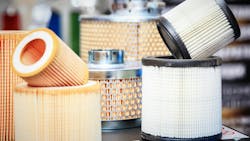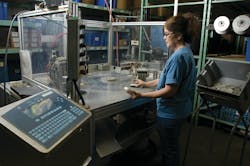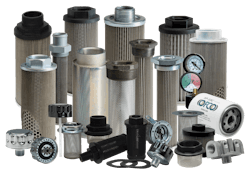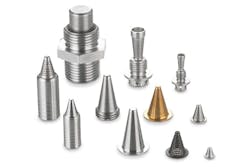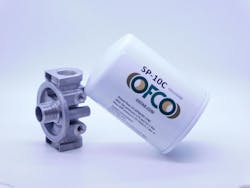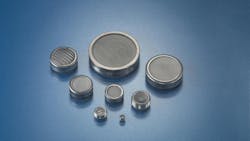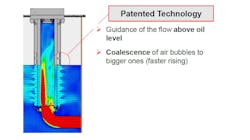Innovation is Transforming Filter Designs for Fluid Power Systems
Filters are an important part of hydraulic and pneumatic systems as they help eliminate the presence of various contaminants which could cause performance issues. And like many other fluid power system components, advancements continue to be made in filter designs to meet evolving customer and industry requirements.
“Over the past 5 years, filtration technology for fluid power systems has seen significant advancements,” said Michael Shaw, CEO of Ohio Fabricators Company. “Customers are now looking for features and capabilities that enhance efficiency, product quality, and environmental sustainability.”
He said some of the key trends and innovations taking place within the filtration industry include:
- Advanced Filter Media: The development of synthetic filter media, including various polymers and fibers, has improved filtration capabilities and durability compared to natural materials.
- Nanotechnology: Emerging technologies like nanotechnology promise more efficient, effective, and environmentally friendly filtration systems.
- Degradation-Based Maintenance: Incorporating elements of degradation-based maintenance in filtration systems helps power plant operators meet their desired performance goals by improving operating costs and power output.
- Environmental Sustainability: Customers are increasingly looking for filtration products that minimize waste, meet environmental regulations, and monitor air and water quality.
“These advancements have transformed filtration technology from its early beginnings to the cutting-edge innovations of today, making it more efficient and versatile than ever before,” said Shaw.
Gregg Shanley, Technical Marketing Manager, Automotive and Industrial at The Lee Company, agrees that filtration technology has evolved to meet the needs of hydraulic and pneumatic systems across multiple technological applications and industries.
“While there have been advancements — especially in aerospace — the goal is still largely the same,” he said. “Customers are looking for filtration products that can provide the contamination protection they need, with the lowest pressure drop possible. By doing so, they are able to use that energy in other places in their systems (instead of at the filter level).”
READ MORE: Filters Play Important Part in Compressed Air System Efficiency
Material Advancements Improving Filtration Performance
An area in which many technological advancements are taking place is in the design of filter materials. The materials used in filters are key to trapping debris to prevent it from entering hydraulic and pneumatic systems, as well as other systems further downstream in machines and vehicles.
According to Shaw, nanofiltration and membrane technologies have emerged as game-changers in industrial fluid handling. “They utilize semi-permeable membranes with extremely fine pores to separate particles, contaminants, and unwanted substances on a molecular level,” he explained. “Nanofiltration systems offer superior filtration efficiency while allowing desired molecules to pass through, making them ideal for applications requiring precise separation of ions, organic matter, and pathogens.”
Shaw went on to say that advancements in membrane materials and structures have increased durability, fouling resistance, and higher permeability, helping to ensure sustained performance in various industrial settings.
He said the nanotechnologies that have been deployed in nonwovens — whether spunbond, meltblown, wetlaid, or apertured films — have led to a step function in products available to the market.
A consistent need for more precise filtration methods in industries such as pharmaceuticals, food and beverage, as well as water treatment have been a key driver he said for these filter material developments.
“These solutions have been driven into industrial filtration applications across many markets [and] hydraulic, lube and fuel filtration markets have all improved from these new technologies as well,” said Shaw. “These markets continue to demand complex filtration solutions that are high efficiency and durable as engines are more precisely built with fuel efficiency and emissions standards in mind.”
Shanley said hydrogen systems are also impacting the material design and pressure needs of fluid power filtration technology. He explained that filter material can be compromised by hydrogen embrittlement, leading to issues with reduced tensile strength, cracking, or other catastrophic failures. Although some materials may be sufficiently resistant to hydrogen embrittlement, he said they can still fail under certain conditions.
“The material selection process is crucial to help ensure compatibility throughout the system, and filter materials need to be sufficient to handle the needs of hydrogen systems,” said Shanley.
He also noted that hydrogen systems typically operate at very high pressures and designers may want to use a restrictive safety screen filter with an extremely low micron rating of about 10 microns or lower.
“Getting down to these lower micron ratings is a challenge in higher pressure systems, as it usually results in reduced material strength,” Shanley explained. “The pressure needs of hydrogen systems are helping to drive innovation to create filters that can handle these increasing pressures without a significant rise in flow resistance.”
Compact Systems are Driving Filter Designs
There is a growing trend toward the development of more compact systems, particularly in the mobile hydraulics sector, as the amount of available space on machines and vehicles continues to decrease.
Shaw noted the size of hydraulic reservoirs, for instance, are decreasing to reduce the weight of mobile equipment as well as improve their aerodynamics, both of which help to lower energy use and emissions — increasingly important factors for OEMs and their customers.
“This has led original equipment manufacturers (OEM) to [use] roto-molded tanks, thermoformed components and integrated filtration systems within tanks,” he said. “All of these developments can stress fluids with less residence time for cooling and evacuation of air molecules.”
READ MORE: A New Approach to Hydraulic Reservoir Designs
With the move to more compact systems, Shaw said hydraulic and lubrication filter manufacturers are now being pressured to offer solutions designed to yield a lower clean pressure drop and longer life while maintaining fluid cleanliness.
The space constraints with which design teams must now work makes it even more critical to consider all necessary filtration technologies as early in the development process as possible.
Shanley said most hydraulic and pneumatic systems are designed with a system filter to maintain fluid cleanliness during operation and reduce wear on parts. However, sensitive components are sometimes located far from the filter. Therefore smaller safety screen filters are often used as a final line of defense to protect components from contamination that may otherwise affect performance.
The need for a safety screen filter, though, is often discovered late in the design process, he said.
He explained that designers sometimes assume their system-level filter will provide enough protection and so do not incorporate additional filters into their initial designs. But testing then reveals potential sources of contamination not previously anticipated, such as rogue contamination and debris generated during manufacturing or produced during operation, can occur.
“As systems become increasingly complex, however, the space available to place filters post-design may be incredibly limited,” said Shanley.
To help overcome this challenge, he said The Lee Company develops safety screen filters in various sizes to meet customer needs. “Adapting to unique system geometries provides us with the flexibility to produce filters optimized to the customer’s performance and pressure requirements — even if their system was originally designed without this filter in mind.”
New Filter Technology Aids Hydraulic Reservoir Optimization
To help its customers see the potential benefits of better optimizing the size of their hydraulic reservoirs, HYDAC offers a Tank Optimization Platform as part of its engineering services. Through simulation and field testing, the company can demonstrate how different geometries and smaller reservoir (also called a tank) sizes can improve performance and operating costs.
A key enabler of this platform is the Air-X Filter developed by HYDAC to extend oil and filter life. On the outside of the filter is wire mesh which coalesces several small air bubbles into larger ones. The larger the air bubble, the more buoyancy it has and thus the faster it can rise and get out of the hydraulic reservoir explained Marcus Herrera, Application Engineer, Advanced Systems Team, HYDAC International during a presentation he gave as part of the National Fluid Power Association’s (NFPA) June 2024 quarterly technology conference.
Removing air from the oil within a reservoir is critical to ensuring the performance of hydraulic systems; the faster a filter can get air out of a hydraulic reservoir, the better.
The wire mesh also guides oil to release above the oil surface. “As the oil comes in, the mesh encourages that oil when it exits the filter to exit at or above the oil level in the tank,” he explained.
Additionally, the filter design slows the velocity of the oil as much as possible. “The faster the velocity, the more likely it is going to create bubbles,” said Herrera. “So, we’re trying to slow it down to allow the bubbles to escape.”
He noted that commonly an out-to-in filter design is used for hydraulic reservoirs, but the Air-X technology is an in-to-out solution. Out-to-in filtration has a slow entrance velocity into the filter and oil is dejected out the bottom of the filter. This creates velocity into the tank though, causing sloshing and vortexes as well as bubbles that might be in the oil to make their way to the bottom of the tank. The bubbles will have to make their way all the way to the top of the oil to escape, he said.
With in-to-out filtration, on the other hand, the inlets coming into the hydraulic reservoir come through the center of the filter and the filter slows down the oil. This allows any bubbles created to escape at the surface of the oil.
As the reservoir filter’s job is to collect contaminants, it will eventually need to be replaced. Spin-on filters are commonly used in the market, Herrera said and are usually thrown out once past their useful life and replaced with a new filter.
To help reduce the amount of waste associated with filter replacement, HYDAC designed the Air-X to have a cartridge inside the filter housing. The cartridge is made with plastics or aluminum so they can be recycled. The goal was to create a filter in which as many of the core components can be reused as possible.
Where is Fluid Power Filtration Technology Headed?
Both Shaw and Shanley see more technological advancements for filters coming in the future to meet the ever-evolving needs of hydraulic and pneumatic systems.
According to Shaw, continued development of advanced filter media using polymers and various fibers will lead to further improvements in filtration capabilities and durability. “These developments, driven by nanotechnologies, will lead to more efficient, effective and environmentally friendly filtration offerings industry wide,” he said.
In addition, implementation of condition-based monitoring on systems will continue to grow, leading to degradation-based maintenance in systems as performance goals dictate less downtime, and the push for reduced operating costs becomes a greater focus.
Shanley said The Lee Company predicts there will be an increasing focus on the development of filtration technology that can accommodate a wider range of fluids – including the incorporation of different materials and processes to filter fluids.
“Additionally, as filtration technology continues to develop and more components become electrified, consideration should be paid to the unique filtration needs of these products in future fluid power systems,” he concluded.
About the Author
Sara Jensen
Executive Editor, Power & Motion
Sara Jensen is executive editor of Power & Motion, directing expanded coverage into the modern fluid power space, as well as mechatronic and smart technologies. She has over 15 years of publishing experience. Prior to Power & Motion she spent 11 years with a trade publication for engineers of heavy-duty equipment, the last 3 of which were as the editor and brand lead. Over the course of her time in the B2B industry, Sara has gained an extensive knowledge of various heavy-duty equipment industries — including construction, agriculture, mining and on-road trucks —along with the systems and market trends which impact them such as fluid power and electronic motion control technologies.
You can follow Sara and Power & Motion via the following social media handles:
X (formerly Twitter): @TechnlgyEditor and @PowerMotionTech
LinkedIn: @SaraJensen and @Power&Motion
Facebook: @PowerMotionTech

Leaders relevant to this article:
